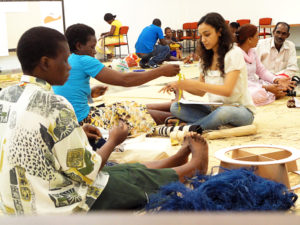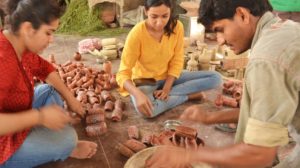
A cluster is defined as a geographic concentration(a city/town/few adjacent villages and their adjoining areas)of units producing near similar products and facing common opportunities and threats.An artisan cluster is defined as geographically concentrated(mostly in villages/townships)household units producing handicraft/handloom products.In a typical cluster,such producers often belong to a traditional community, producing the long-established products for generations.Indeed, many artisan clusters are centuries old Artisan.
About Daskoi TalukaCluster:-
Daskoi Taluka Cluster falls under Gujarat State in Ahmedabad district.
The Daskoi Taluka cluster is able to form 250 plus Artisans & 18 SHGs supporting the strong work force.The mobilisation gains momentum day by day.
Embroidery:-
|
The term embroidery is basically defined as the method of ornamenting a piece of clothing with needlework;or embellishment with fanciful details.Thus embroidery is regarded as the art of decorating textiles using a needle and thread.Embroidery of Gujarat has earned its fame because of the versatility of creations by the artisans.The artisans of Gujarat use an array of stitches that are used to decorate the items.The most important centres of embroidery work of Gujarat are located in the Sarasota and Kutch regions and are admired for the creative excellence.The embroidery of Gujarat is one of the main sources of income for different other communities.Today,even though embroidery is amongst the most traditional methods of decorating clothes,it is still as popular.Designs may date back to ancient times,or the modern geometric modern day designs,but all the same embroidery continues to be one of the common ways of decorating clothes.In fact,specialists feel that today,there is much more scope for creativity and innovation,because of the acceptance level. |
 Ari embroidery of Gujarat has its international market in Nigeria where women drape themselves(during ceremonial occasions)in the embroidered cloth from this region.This has ornamentation of tikris and beads, which make them, look attractive.This type of embroidery is done on a frame of wooden beams.The fabric is worked upon with a long needle, threads, tikris and beads.Multi sized frames are used,usually about 1.5 feet high, to secure the cloth on which the design is sketched with a stencil.One hand secures the thread under the cloth to the needle while the other hand moves the needle on top of the cloth with ease.Decorative tikris and beads are attached to the cloth with the needle.
Ari embroidery of Gujarat has its international market in Nigeria where women drape themselves(during ceremonial occasions)in the embroidered cloth from this region.This has ornamentation of tikris and beads, which make them, look attractive.This type of embroidery is done on a frame of wooden beams.The fabric is worked upon with a long needle, threads, tikris and beads.Multi sized frames are used,usually about 1.5 feet high, to secure the cloth on which the design is sketched with a stencil.One hand secures the thread under the cloth to the needle while the other hand moves the needle on top of the cloth with ease.Decorative tikris and beads are attached to the cloth with the needle.
Another embroidery pattern is the jaali or net embroidery in geometric or floral shapes and is done by pulling the warp and weft threads and fixing them with minute buttonhole stitches.The finished products dominantly comprise items for household use like curtains, bedspreads, furniture covers and dress material.
Raw Materials used:-
The fabric is worked upon with a long needle,threads, tikris and beads.Multi sized frames are used, usually about 1.5 feet high, to secure the cloth on which the design is sketched with a stencil.One hand secures the thread under the cloth to the needle while the other hand moves the needle on top of the cloth with ease.
Process:-
As embroidery is not so technical craft to follow procedure but then also small process like:
Set the fabric(Saree, Dress, material,etc.)on Wooden frame(it can be done without frame also)according to the design with desired allowance for the product.The motif is made the tracing screen for symmetrical making and uniformity, like the Khaka.The motif is marked with a marking mixer in a liquid form(Kerosene and gali powder) whether for embroidery the desired motif is neatly embroidery with different stitches to achieve desired motif.
Embroidery designs are prepared by fixing small round shaped mirrors to the material with the help of the buttonhole stitch, the outline being sketched by hand.Silken thread is used for the stitching done in stem or herringbone, closely worked.Flowers and creepers are patterned against a dark background.
Techniques:–
Techniques vary with the community and region.The term embroidery is basically defined as the method of ornamenting a piece of clothing with needlework; or embellishment with fanciful details.Thus embroidery is regarded as the art of decorating textiles using a needle and thread.This includes the hand and machine embroidery methods.And till date,hand embroidery continues to be an expensive and time-consuming method.However, in spite of this it is preferred because of the intricacy of the handiwork involved.
The basic techniques an embroiderer uses includes:–
 NIFT with the active support from the Ministry of Textiles, Office of Development Commissioner (Handlooms) and Office of Development Commissioner (Handicrafts) has developed and implemented a new Craft Cluster Initiative Program which aims to provide the students with continuous exposure to the handloom and handicraft clusters, thus providing an opportunity for creative innovation and experimentation. Through this initiative, NIFT aims to reach out to the artisans and craftsmen at the grass root level. The artisans and craftsmen involved in the initiative will benefit through knowledge dissemination and exposure to urban markets and design intervention, innovative designs and linkages with new markets.
NIFT with the active support from the Ministry of Textiles, Office of Development Commissioner (Handlooms) and Office of Development Commissioner (Handicrafts) has developed and implemented a new Craft Cluster Initiative Program which aims to provide the students with continuous exposure to the handloom and handicraft clusters, thus providing an opportunity for creative innovation and experimentation. Through this initiative, NIFT aims to reach out to the artisans and craftsmen at the grass root level. The artisans and craftsmen involved in the initiative will benefit through knowledge dissemination and exposure to urban markets and design intervention, innovative designs and linkages with new markets.
The Craft Cluster initiative at NIFT is designed with the objectives to sensitize NIFT students to the realities of the craft sector and give insight into regional sensibilities and diversities, resources and environment. Through this initiative, NIFT has been successful in creating a widespread awareness and sensitivity in assimilating crafts into fashion and vice-versa. The Craft Cluster Initiative program is envisaged to provide the students of NIFT systematic, continuous and regular exposure every year to the diversely rich and unique handlooms and handicrafts of India. Under this dynamic initiative, the students of NIFT work closely with the artisans and weavers in clusters of India and undertake activities like diagnostic study, design intervention and prototype development. The artisans and weavers are also invited to NIFT campuses for exposure workshops, demonstration workshops, exhibitions and craft bazaars where they get an opportunity to interact with the craft experts, upgrade their product and design knowledge and understand consumers in the urban markets.
Post Tagged with Best NIFT coaching in Delhi, Best NIFT GD/PI coaching in Delhi, Best Pearl coaching in Delhi, Fashion design institutes in Delhi, NID Coaching in Hauz Khas, NID Coaching in Lucknow, NIFT Coaching in Hauz Khas, NIFT coaching in Kolkata, NIFT Coaching In Lucknow, NIFT Coaching in Patna, NIFT coaching in Pitampura, NIFT coaching in South Delhi, NIFT Interview Coaching, NIFT MFM Coaching, NIFT Personal Interview Coaching In Delhi